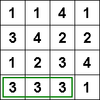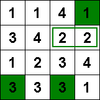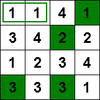Hitori
Hitori ( Japanese ひ と り に し て く れ Hitori ni shite kure , German 'leave me alone' ) is a mystery from the Japanese publisher Nikoli . It first appeared in Puzzle Communication Nikoli 29 (March 1990). The puzzle is also known as the stroke of a pen .
regulate
Hitori is played on a square grid. All squares contain numbers. The aim is to identify squares with "wrong" numbers and to mark them in color or to highlight them in some other way until the following properties are met:
- In each row and in each column, each number appears only once without highlighting.
- The highlighted squares must not adjoin one another on one edge.
- The remaining white squares must be connected by edges.
Usually the given numbers clearly define the solution.
Solution methods
Web links
Commons : Hitori - collection of images, videos and audio files
- Hitori tutorials (English)
- Hitori (janko.at)
- The Hitori Solver (algorithm, Java program with source code)







